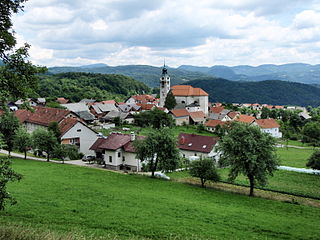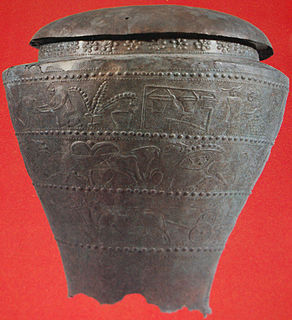
Slovenia, officially the Republic of Slovenia, is a country in Central Europe. It is bordered by Italy to the west, Austria to the north, Hungary to the northeast, Croatia to the southeast, and the Adriatic Sea to the southwest. Slovenia is mostly mountainous and forested, covers 20,271 square kilometers (7,827 sq mi), and has a population of 2.1 million, of which 500,000 live in the capital and largest city Ljubljana. Slovenes form the vast majority of the country's population, while Serbs are the largest minority. Slovene, a South Slavic language, is the official language. Slovenia has a predominantly continental climate, with the exception of the Slovene Littoral and the Julian Alps. A sub-mediterranean climate reaches to the northern extensions of the Dinaric Alps that traverse the country in a NW-SE direction. The Julian Alps in the northwest have an alpine climate. Continental climate is increasingly more pronounced towards the Pannonian Plain in the Northwest. The nation's capital and largest city—Ljubljana—is situated at roughly the centre of the country.

The Hallstatt culture was the predominant Western and Central European culture of Late Bronze Age from the 12th to 8th centuries BC and Early Iron Age Europe from the 8th to 6th centuries BC, developing out of the Urnfield culture of the 12th century BC and followed in much of its area by the La Tène culture. It is commonly associated with Proto-Celtic populations. Older assumptions of the early 20th century of Illyrians having been the bearers of especially the Eastern Hallstatt culture are indefensible and archeologically unsubstantiated.

Novo Mesto is a city on a bend of the Krka River in the City Municipality of Novo Mesto in southeastern Slovenia, close to the border with Croatia. The town is traditionally considered the economic and cultural centre of the historical Lower Carniola region.

Ottonian art is a style in pre-romanesque German art, covering also some works from the Low Countries, northern Italy and eastern France. It was named by the art historian Hubert Janitschek after the Ottonian dynasty which ruled Germany and northern Italy between 919 and 1024 under the kings Henry I, Otto I, Otto II, Otto III and Henry II. With Ottonian architecture, it is a key component of the Ottonian Renaissance. However, the style neither began nor ended to neatly coincide with the rule of the dynasty. It emerged some decades into their rule and persisted past the Ottonian emperors into the reigns of the early Salian dynasty, which lacks an artistic "style label" of its own. In the traditional scheme of art history, Ottonian art follows Carolingian art and precedes Romanesque art, though the transitions at both ends of the period are gradual rather than sudden. Like the former and unlike the latter, it was very largely a style restricted to a few of the small cities of the period, and important monasteries, as well as the court circles of the emperor and his leading vassals.

King Matjaž/Mátyás is a legendary king in Slovenia, Hungary, Croatia and in some other countries, based on pre-Christian traditions of Carantania and in course of centuries gradually linked to a real-life king, Matthias Corvinus of Hungary, who lived in the second half of the 15th century. He has also been linked to the leader of the peasant's army that fought against the Turks in the Battle of Kokovo in July 1478. A number of folk poems and stories about King Matjaž are known, the earliest ones originating in the western Slovene area of Tolmin from the 16th century. He is mainly represented as the king who is just and a defender of his people, and the bringer of the golden age of prosperity. It has been assumed that the legend was the basis for the name of the 1573 peasants' revolt leader Matija Gubec, actually named Ambrož Gubec.

Situla, from the Latin word for bucket or pail, is the term in archaeology and art history for a variety of elaborate bucket-shaped vessels from the Iron Age to the Middle Ages, usually with a handle at the top. All types may be highly decorated, most characteristically with reliefs in bands or friezes running round the vessel.

The Alpine foothills, or Prealps can refer generally to any foothills at the base of the European Alps. They are the transition zone between the High Alps to the Swiss Plateau and the Bavarian Alpine Foreland in the north, as well as to the Pannonian Basin (Alpokalja) in the east, the Padan Plain in the south and the Rhone Valley in the west.

The European ratsnake or leopard snake, is a species of nonvenomous colubrid snake endemic to Europe, Asia Minor, and the Caucasus.

Dražgoše is a village in the Municipality of Železniki in the Upper Carniola region of Slovenia. The village lies on the southern slopes of the Jelovica Plateau. The settlement consists of three hamlets: Pri Cerkvi, Na Pečeh, and Jelenšče.

Jevšček is a small settlement in the Municipality of Kobarid in the Littoral region of Slovenia, right on the border with Italy.

Vače is a settlement in the Municipality of Litija in central Slovenia. The area is part of the traditional region of Upper Carniola and is now included with the rest of the municipality in the Central Sava Statistical Region.

Črneča Vas is a settlement in the Municipality of Kostanjevica na Krki in eastern Slovenia. It lies in the Gorjanci hills close to the border with Croatia. The area is part of the traditional region of Lower Carniola. It is now included in the Lower Sava Statistical Region.

Klenik is a settlement east of Vače in the Municipality of Litija in central Slovenia. The area is part of the traditional region of Upper Carniola. It is now included with the rest of the municipality in the Central Sava Statistical Region; until January 2014 the municipality was part of the Central Slovenia Statistical Region.

The Vače Situla is an ornamented Early Iron Age ritual bronze vessel (situla) found in the second half of the 19th century at the Hallstatt Archaeological Site in Vače in central Slovenia. It counts among the highest-quality such vessels in general and among the most precious archeological artifacts of the country. Dating from the 5th century BC, it is considered to be one of the oldest situla objects of the northern Illyrians found in the Eastern Hallstatt zone. The vessel has three rows of relief that show the ordinary life of the ruling class and also reflect the religious understanding of the world in that time. It is on display in the National Museum of Slovenia.
The Vače Belt-Plate is one of the best examples of Illyrian art and toreutic art.
The Japodian burial urns are a series of fifteen burial urns made by the Illyrian tribe of the Japodes around the area of Bihać in Bosnia. These cremation urns where the cremated remains of the dead were placed in, were beautifully decorated with figurative designs of humans and animals. The Japodian burial urn art was a unique form of art influenced to a degree by the Situla art of northern Illyria and Italy and by Greek art. The urns represent one of the best Japodian figurative art forms.

The Municipality of Litija is a municipality in central Slovenia. The seat of the municipality is the town of Litija. The area is part of the traditional Upper and Lower Carniola regions. The entire municipality is now included in the Central Sava Statistical Region; until 2015 it was part of the Central Slovenia Statistical Region. The population of the municipality is just over 15,000.
The Hallstatt Archaeological Site in Vače is an Eastern Hallstatt archaeological site in Klenik, a village near Vače on the border between the Styria and Lower Carniola regions in central-eastern Slovenia. It is best known for the Vače Situla, one of the most notable archaeological treasures of Slovenia.

The Benvenuti Situla is a bronze situla that dates to ca. 600 B.C. It is a product of the situla art that spread north from the Etruscans in this period, in this case to the Este culture that flourished in Este, Veneto during the 7th century BC. The vessel is now conserved in the local National Museum Atestino. The relief work on the vessel depicts scenes of aristocratic life. These include banqueting as well as scenes of military victory. The iconography of the relief scenes of the situla may indicate Etruscan influence.

The Cathedral of the Assumption of the Blessed Virgin Mary also called Koper Cathedral is the Catholic cathedral of the Diocese of Koper, in the city of Koper, Slovenia.















